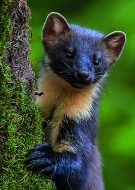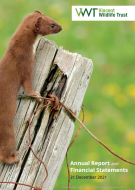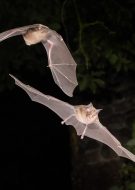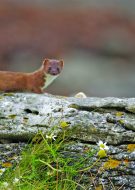
The marbled polecat (Vormela peregusna) is a small mustelid that occurs from the Balkans to Mongolia and is listed as vulnerable under the International Union for Conservation of Nature’s (IUCN) Red List. There are currently no efficient methods to monitor populations at a broad scale and most records come from opportunistic sightings. However, the elusive nature and unique pelage of the species often results in a lot of interest when sighted, with observations regularly being shared on social media platforms. Such records from social media can provide an extensive source of freely available information that could be used to inform the species’ distribution. In this study, we systematically collected marbled polecat records from five social media platforms by using a manual and automated search targeting the western range of the species.
Photo: Marbled polecat ©Zoofanatic
Download
Our latest Open Access paper led by Lizzie Croose is out. We investigated the use of different survey methods (cameras, live-trapping, hair-tubes and eDNA) to detect the critically endangered European mink.
Photo: European mink captured on trail camera
Download
This newsletter highlights the work of 2022 and celebrates the achievements for mammal conservation in Britain, Ireland and further afield during this year.
Photo: ©Jason Hornblow
Download
This paper published in the Conservation Evidence journal details how effective building management at VWT’s bat reserves has resulted in stronger greater and lesser horseshoe bat population size increases compared with unmanaged sites.
Download
Vincent Wildlife Trust has just published its Annual Report for 2021. This report gives an overview of the past year’s highlights, its projects, its partners and its audited financial statements.
Download
The Lynx to Scotland study sought to assess the social feasibility of potential lynx reintroduction to Scotland through consultation with stakeholders and communities in two focal areas – Cairngorms National Park (CNP) and Argyll. Whilst the ecological feasibility of lynx reintroduction has been approached by previous efforts for Scotland, the Lynx to Scotland study represents the first effort to assess social feasibility. This is of central importance for the proposed reintroduction of a large carnivore that has been absent from Britain for a period of time equivalent to multiple human generations. The backbone of the study constituted an academic investigation using Q-Methodology, a technique used to quantify the subjective views of people towards a given topic.
Photo: ©Pexels-David Selbert
Download
VWT’s Newsletter for 2021 has just been published and highlights the work during this past year and the achievements for mammal conservation in Britain and Ireland.
Photo: ©Andrew McCarthy
Download
The Irish stoat M. erminea hibernica is a subspecies endemic to Ireland and the Isle of Man but, despite being widespread in Ireland, no information exists on its population status due to the difficulty of detection. This study compared the efficacy of two camera trap methods (the Mostela, a modified camera trapping device, and an external camera trap outside the Mostela) to detect Irish stoats in counties Mayo and Galway, Republic of Ireland. It also evaluates the potential applicability of both methods for future work to assess the population and conservation status of this little-studied species.
Photo: Irish stoat ©Carrie Crowley (Crossing the Line Films)
Download
Habitat suitability models (HSM) have been used to understand the impacts of landscape-scale habitat connectivity and gene flow mostly by assuming a regular decrease in the cost of movement as habitat improves. Yet, habitat selection and gene flow are governed by different behavioural processes which may limit the reliability of this approach. This study aimed to identify the optimal relationship between gene flow and HSMs for two bat species (Myotis bechsteinii and Eptesicus serotinus) in Britain in order to inform future bat conservation studies.
Photo: ©Frank Greenaway
Download